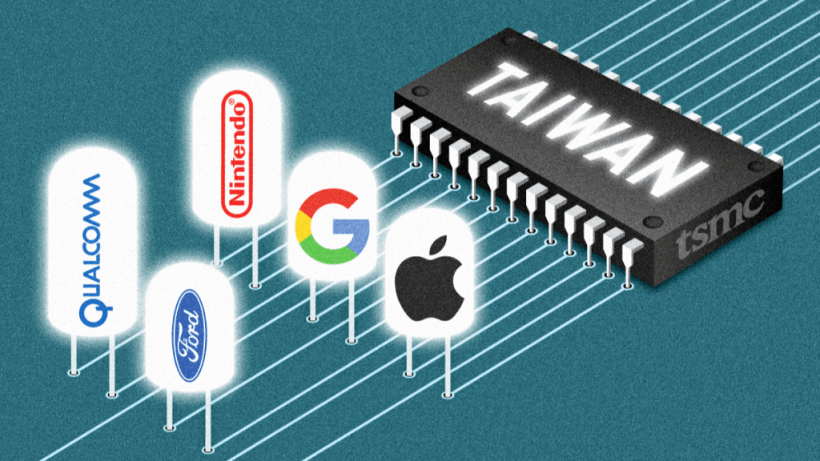
Understanding the importance of semiconductors and all the implications of the latest related crises will help you understand the world better!
Semiconductors have become a topic of the day in various environments, due to the severe difficulties the world is facing with the so-called microchip crisis. Incredible as it may seem, this crisis has been occupying an increasing space in the economic and political news.
For this very reason, considering all the questions, we decided to make a small dossier for you, bringing the main information about this situation.
In this article, you will understand what semiconductors are, how a microchip is produced, the difficulties of the advances of these Industries and the political and economic consequences that are emerging from this problem.
Our intention here is to bring the information in the most unbiased way possible. We are not going to take sides with any of the “sides”, nor make a value judgment of any ideology. The goal is to bring you information from the facts and let you make the most moral decisions.
What are semiconductors?

Semiconductors are components that have a partial conduction of electrical energy, and therefore can be used in microelectronics.
The main semiconductor used is silicon, which has even become a reference when we talk about technology companies, as in "Silicon Valley", in the United States, where large technology companies have developed and are headquartered.
Because of their great importance in the microelectronics market, the semiconductors and microchips have been causing various disputes and being considered by some specialists as the “new oil”.
The big question regarding semiconductors is that, unlike oil, which is comparatively simple to process and can be enriched in different parts of the world, microchips are in a totally different situation, which we will explore a little later.
As you will also see in our next topic, building a microchip factory is expensive and implementing it is difficult and time-consuming.
Even more so when we talk about the latest chips, whose manufacturing is still extremely limited and is in the hands of very few entrepreneurs.
With companies located in the United States, China, Taiwan, and Europe, it's not like there's a huge market with a lot of competition within the microchip world. In fact, what we are seeing is exactly the opposite, the scarcity of chips is causing an increase in the prices of electronic products, at a time when the world needed them so much, during the Covid-19 pandemic.
Before delving into the social, economic and political aspects of semiconductors and the semiconductor crisis, we want to show you how complex the production of a microchip can be.
What does a microchip fab look like?
Microchip factories, generally called fab or foundry, transform raw semiconductors into true micro pieces of technological art.
They work in a very complex way, with an incredible series of details in their construction, to have an environment as free of interference as possible, because with the size of the microchips being produced decreasing more and more, things that in other factories are irrelevant, like dust, they become a terrible adversary to product quality and accuracy.
The production of microchips is done without any human manipulation and initially starts with the production of the Wafer, which is the nickname given to the silicon plate where the chip is “written”.
The process begins with the creation of a sand-melted silicon crystal. This crystal is then “sliced”, similar to a salami or sausage, and the slices are given the name of wafer.
The process of inscribing the microchip is done by starting chemical baths and a process called photolithography, which involves infrared light, photoresistant products and the result is the design of the circuit.
After that, it is important to point out that this explanation is tremendously simplified, the wafer is again broken into the shape of microchips (each wafer can have hundreds or even thousands of microchips) and then covered with the protective plastic layer.
There is a considerable loss of chips in this process, but so far this has been the only way developed to produce chips in the size needed for virtually every technology in today's world.
It is important to point out that the foundry has 4 floors and in only one of them 2 microchips are actually manufactured.
The environment inside these factories is controlled and each floor has a gridded floor, so that there is no accumulation of dust and dirt. Employees circulate in special clothes, with only their eyes uncovered.
The fab's own air conditioning is designed so that all the dust goes down to the ground floor, where only maintenance services and the transport of ready-made microchips are carried out.
It is also important to note that the production capacity of each of these factories is not very large, and most factories in the world are working at full steam.
As we have already commented, a few factories in the world are responsible for all the production of microchips on the planet and this becomes even worse when we discover that more than half of this production is centralized in a single factory, and the very existence of this foundry is capable of rekindling old disputes and start a war
TSMC: Understand how this factory stopped the world

TSMC is a chip factory in Taiwan that, according to Trend Force, has 55% of the global market share in the first quarter of 2021. This makes it, without a doubt, one of the most important companies in the world right now.
It turns out that, during the pandemic last year, Taiwan experienced a serious drought, which affected TSMC's production.
It affected to such an extent that it had worldwide repercussions, repercussions that caused the values of cell phones, computers and other electronic components that use microchips to have a considerable increase in value.
In addition, there is the whole issue involving vehicle manufacturers, eager buyers of microchips for the electronic systems of vehicles.
It is customary for automakers not to keep large amounts of inputs in stock, so when the pandemic slows down car sales, automakers stop asking TSMC for microchips.
But with the return of the economy in most of the world, caused by the end of the lockdowns, the automakers returned to desire the chips, as other markets had already absorbed the demand, there was a problem of lack of chips for everyone
These issues (the problems with the drought in Taiwan and the increase in demand) ended up happening almost in succession, which made the crisis even bigger.
That's because when we talk about recovery in the market, it's not like it's possible to produce a lot more chips simply by will.
We commented above that chip fabs cannot produce much more than what they already produce. This means that for inventories to normalize and values to return to normal, demand would need to decrease, and this does not seem to be happening any time soon.
It also turns out that there is an additional problem for TSMC's competitors.
The company is already entering pioneering aspects in the production of microchips that are extremely difficult and expensive to obtain. In its most recent advance, TSMC has announced that it offers its customers ultraviolet lithography process, allowing the designed chips to have 1 and 2 nanometers of line.
This company was also responsible for the creation of a whole segment of companies interested in designing microchips, but that did not have the machinery to produce them.
By outsourcing this extremely difficult and expensive part of the microchip production process, these companies were able to find interesting niche markets for themselves, even though they had developed a complete dependency on fabs like TSMC. Nvidia is a good example of these companies.
You can already see that the title of the largest semiconductor company in the world was not conquered by TSMC for nothing.
Another important aspect about TSMC is that it has a very positive relationship with the Taiwanese government, which was fundamental to the start of the company, but which is going through a very complex situation.
The geopolitical effects of the semiconductor crisis.
If you've been following international political and economic journalism, you know that there is a real trade war going on between the United States and China.
This trade war started in the Trump administration and, even with a different philosophy in many respects, it has been maintained in the Biden administration.
The US government created barriers for Chinese industries, which literally prohibited chip-producing companies in the United States from doing business with Chinese companies. In addition, the government also banned Huawei, a Chinese company specializing in 5G, from operating in the US market.
This made the relationship, which was already bad between the two countries, to become even worse.
Furthermore, the process of arm wrestling between companies in these two countries over the supremacy of ever better and smaller microchip technology can be compared to the space race or the nuclear race of the last century.
Now add the fact that Taiwan was a Chinese province, but which, during the 40s, managed to liberate itself through a revolution.
There are fears that China will move militarily towards Taiwan more definitively, and the pursuit of its supremacy in microchips would be an excellent bonus.
It is important to remember the barrier that TSMC has created in relation to its competitors creates what we call a natural monopoly, which is basically the absolute difficulty of competing with a certain company, because the investments to get to where this company is at the moment are simply too high for for a company to do so without government stimulus.
In another aspect, both the American blockade and the possibility of China attracting engineers and other professionals related to microchips from Taiwan and elsewhere in the world with incredible salaries means that China still should not be completely neglected in its new market initiative.
China, right now, is the biggest exporter of electronics in the world, but this entire amazing industry is totally defenseless to the microchip crisis.
To resolve this issue, the Chinese Communist Party created a government program to encourage the creation of more and more Chinese chip factories.
The Chinese plan for this situation involves the promise that China will become totally independent of foreign chips by 2025, which would make the country practically unstoppable in this market.
This plan involves the acquisition of both technology and human capital, in addition, of course, to ensuring good raw material suppliers.
Are semiconductors the new oil?
This is the bet of many specialists in geopolitics and economics. The decline of the oil market, due to ecological issues and also the advance of clean energy and electric cars, make semiconductors end up becoming the new great bargaining chip.
The construction of new foundries and the stimulation of this entire market will probably end up becoming the target of public policies to stimulate industrialization, as happened with other markets decades ago.
This is because, as we have already noticed, from now on, a country's chip production capacity may end up becoming a paradigm of its economic (and even political and military) power.
Is there a chance the semiconductor crisis could escalate into a conflict?

This is a relatively difficult question to answer. Right now, the world's economies are trying to rebuild from the monumental damage the pandemic has caused. It does not seem likely that an escalation of violence could ensue between the United States and China, which could, with some ease, escalate into a new World War.
At the same time, it doesn't seem difficult to conclude that China has every reason in the world to regain control over Taiwan, despite the island's thinking differently.
It is important to point out that the problems between China and Taiwan go far beyond chips. Since 2013, when current Chinese leader Xi Jinping assumed the presidency of China, there have been almost daily threats to Taiwan's airspace from Chinese military planes.
From a military point of view, the United States is Taiwan's ally, since in addition to sharing economic points of view, both have points in common against China.
As you can see, the semiconductor crisis is much more interesting and complex than initially imagined, involving political and economic issues that are much older than the very technologies that are used as weapons and currency of exchange today.
That you enjoyed this content. Did you feel that some data was missing or something like that? Comment below!












